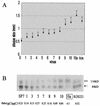Strain-dependent structural variants of herpes simplex virus type 1 ICP34.5 determine viral plaque size, efficiency of glycoprotein processing, and viral release and neuroinvasive disease potential
- PMID: 12610116
- PMCID: PMC149531
- DOI: 10.1128/jvi.77.6.3409-3417.2003
Strain-dependent structural variants of herpes simplex virus type 1 ICP34.5 determine viral plaque size, efficiency of glycoprotein processing, and viral release and neuroinvasive disease potential
Abstract
The ability of certain strains of herpes simplex virus type 1 (HSV-1) to cause encephalitis or neuroinvasive disease in the mouse upon peripheral infection is dependent on a combination of activities of specific forms of viral proteins. The importance of specific variants of ICP34.5 to neuroinvasive disease potential and its correlation with small-plaque production, inefficient glycoprotein processing, and virus release were suggested by comparison of ICP34.5 from the SP7 virus, originally obtained from the brain of a neonate with disseminated disease, and the tissue culture-passaged progeny of SP7 (SLP5 and SLP10) and the KOS321 virus. SLP5, SLP10, and KOS321 are attenuated and exhibit a large-plaque phenotype, including efficient glycoprotein processing and viral release. We show that expression of the KOS321 ICP34.5 protein in cells infected with SP7 or ICP34.5 deletion mutants promotes large plaque formation and efficient viral glycoprotein processing, while expression of the SP7 ICP34.5 protein decreases efficiency of viral glycoprotein processing. In addition, a recombinant virus, 4hS1, with the SP7 ICP34.5 gene replacing the KOS321-like ICP34.5 gene in the SLP10a background, rescues the small-plaque phenotype and neuroinvasive disease. The major difference in the ICP34.5 gene product is the number of Pro-Ala-Thr repeats in the middle region of the protein, with 18 for SP7 and 3 for KOS321. Strain-dependent differences in the ICP34.5 protein can therefore alter the tissue culture behavior and the virulence of HSV-1.
Figures





Similar articles
-
Interplay between Autophagy and Herpes Simplex Virus Type 1: ICP34.5, One of the Main Actors.Int J Mol Sci. 2022 Nov 7;23(21):13643. doi: 10.3390/ijms232113643. Int J Mol Sci. 2022. PMID: 36362429 Free PMC article. Review.
-
Intrastrain variants of herpes simplex virus type 1 isolated from a neonate with fatal disseminated infection differ in the ICP34.5 gene, glycoprotein processing, and neuroinvasiveness.J Virol. 1999 May;73(5):3843-53. doi: 10.1128/JVI.73.5.3843-3853.1999. J Virol. 1999. PMID: 10196279 Free PMC article.
-
HSV-2 ICP34.5 protein modulates herpes simplex virus glycoprotein processing.Arch Virol. 2009;154(4):661-3. doi: 10.1007/s00705-009-0341-9. Epub 2009 Mar 7. Arch Virol. 2009. PMID: 19267180
-
Neurovirulent factor ICP34.5 uniquely expressed in the herpes simplex virus type 1 Delta gamma 1 34.5 mutant 1716.J Neurovirol. 2008 Jan;14(1):28-40. doi: 10.1080/13550280701769999. J Neurovirol. 2008. PMID: 18300073
-
Role of Herpes Simplex Virus 1 γ34.5 in the Regulation of IRF3 Signaling.J Virol. 2017 Nov 14;91(23):e01156-17. doi: 10.1128/JVI.01156-17. Print 2017 Dec 1. J Virol. 2017. PMID: 28904192 Free PMC article.
Cited by
-
Genotypic and Phenotypic Diversity of Herpes Simplex Virus 2 within the Infected Neonatal Population.mSphere. 2019 Feb 27;4(1):e00590-18. doi: 10.1128/mSphere.00590-18. mSphere. 2019. PMID: 30814317 Free PMC article.
-
Functional genomic analysis of herpes simplex virus type 1 counteraction of the host innate response.J Virol. 2006 Aug;80(15):7600-12. doi: 10.1128/JVI.00333-06. J Virol. 2006. PMID: 16840339 Free PMC article.
-
Interplay between Autophagy and Herpes Simplex Virus Type 1: ICP34.5, One of the Main Actors.Int J Mol Sci. 2022 Nov 7;23(21):13643. doi: 10.3390/ijms232113643. Int J Mol Sci. 2022. PMID: 36362429 Free PMC article. Review.
-
Herpes Simplex Virus 1 γ134.5 Protein Inhibits STING Activation That Restricts Viral Replication.J Virol. 2018 Sep 26;92(20):e01015-18. doi: 10.1128/JVI.01015-18. Print 2018 Oct 15. J Virol. 2018. PMID: 30045990 Free PMC article.
-
Persistent Infection with Herpes Simplex Virus 1 and Alzheimer's Disease-A Call to Study How Variability in Both Virus and Host may Impact Disease.Viruses. 2019 Oct 20;11(10):966. doi: 10.3390/v11100966. Viruses. 2019. PMID: 31635156 Free PMC article. Review.
References
-
- Allen, P. B., Y. G. Kwon, A. C. Nairn, and P. Greengard. 1998. Isolation and characterization of PNUTS, a putative protein phosphatase 1 nuclear targeting subunit. J. Biol. Chem. 273:4089-4095. - PubMed
-
- Bergstrom, T., A. Vahlne, K. Alestig, S. Jeansson, M. Forsgren, and E. Lycke. 1990. Primary and recurrent herpes simplex virus type 2-induced meningitis. J. Infect. Dis. 162:322-330. - PubMed
Publication types
MeSH terms
Substances
Grants and funding
LinkOut - more resources
Full Text Sources
Other Literature Sources

